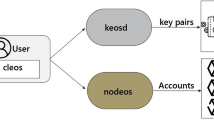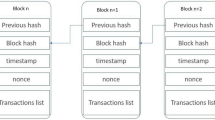Abstract
Traditional centralized optimization and management schemes may be incompatible with a changing energy system whose structure is becoming increasingly distributed. This challenge can hopefully be addressed by blockchain. However, existing blockchains have not been well prepared to integrate mathematical optimization, which plays a key role in many energy system applications. Here we propose a blockchain consensus mechanism tailored to support mathematical optimization problems, called Proof of Solution (PoSo). PoSo mimics Proof of Work (PoW) by replacing the meaningless mathematical puzzle in PoW with a meaningful optimization problem. This is inspired by the fact that both the solutions to the puzzle and to an optimization problem are hard to find but easy to verify. We show the security and necessity of PoSo by using PoSo to enable energy dispatch and trading for two integrated energy systems. The results show that compared with existing optimization schemes, PoSo ensures that only the optimal solution is accepted and executed by participants. Further, compared with existing blockchains, PoSo can seamlessly incorporate mathematical optimization and minimize the workload associated with searching and verifying the optimum.
This is a preview of subscription content, access via your institution
Access options
Access Nature and 54 other Nature Portfolio journals
Get Nature+, our best-value online-access subscription
$29.99 / 30 days
cancel any time
Subscribe to this journal
Receive 12 digital issues and online access to articles
$119.00 per year
only $9.92 per issue
Buy this article
- Purchase on Springer Link
- Instant access to full article PDF
Prices may be subject to local taxes which are calculated during checkout



Similar content being viewed by others
Data availability
The data relevant to system parameters and optimization results of the two IESs are available at https://github.com/kelpman05/DataUofManchester and https://github.com/kelpman05/DataWuzhong.
Code availability
The computational code is available at https://github.com/kelpman05/CodePoSoNE.
References
Morstyn, T., Farrell, N., Darby, S. J. & McCulloch, M. D. Using peer-to-peer energy-trading platforms to incentivize prosumers to form federated power plants. Nat. Energy 3, 94–101 (2018).
Parag, Y. & Sovacool, B. K. Electricity market design for the prosumer era. Nat. Energy 1, 16032 (2016).
Liu, X. & Mancarella, P. Modelling, assessment and sankey diagrams of integrated electricity–heat–gas networks in multi-vector district energy systems. Appl. Energy 167, 336–352 (2016).
Thomas, L., Zhou, Y., Long, C., Wu, J. & Jenkins, N. A general form of smart contract for decentralized energy systems management. Nat. Energy 4, 140–149 (2019).
Kargarian, A. et al. Toward distributed/decentralized DC optimal power flow implementation in future electric power systems. IEEE Trans. Smart Grid 9, 2574–2594 (2018).
Andoni, M. et al. Blockchain technology in the energy sector: a systematic review of challenges and opportunities. Renew. Sust. Energy Rev. 100, 143–174 (2019).
Di Silvestre, M. L. et al. Blockchain for power systems: current trends and future applications. Renew. Sust. Energy Rev. 119, 109585 (2020).
Belotti, M., Božić, N., Pujolle, G. & Secci, S. A vademecum on blockchain technologies: when, which, and how. IEEE Commun. Surv. Tutor. 21, 3796–3838 (2019).
Hassan, N. U., Yuen, C. & Niyato, D. Blockchain technologies for smart energy systems: fundamentals, challenges, and solutions. IEEE Ind. Electron. Mag. 13, 106–118 (2019).
Nakamoto, S. Bitcoin: A Peer-to-Peer Electronic Cash System (Bitcoin, 2008).
Etherscan (Etherscan, 2015); https://etherscan.io/
Comprehensive Guide to Companies Involved in Blockchain & Energy (SolarPlaza, 2018).
Li, J., Li, N., Peng, J., Cui, H. & Wu, Z. Energy consumption of cryptocurrency mining: a study of electricity consumption in mining cryptocurrencies. Energy 168, 160–168 (2019).
Kiayias, A., Russell, A., David, B. & Oliynykov, R. A Provably Secure Proof-of-Stake Blockchain Protocol. In Annual International Cryptology Conference (eds Katz, J. et al.) 357–388 (Springer, 2017).
Fan, X. & Chai, Q. Roll-DPoS: a randomized delegated proof of stake scheme for scalable blockchain-based Internet of things systems. In Proc. 15th EAI International Conference on Mobile and Ubiquitous Systems: Computing, Networking and Services (eds Schulzrinne, H. et al.) 482–484 (ACM, 2018).
Rouhani, S. & Deters, R. Performance analysis of Ethereum transactions in private blockchain. In 8th IEEE International Conference on Software Engineering and Service Science (eds Li, W. et al.) 70–74 (IEEE, 2017).
Miller, A., Juels, A., Shi, E., Parno, B. & Katz, J. Permacoin: repurposing Bitcoin work for data preservation. In 2014 IEEE Symposium on Security and Privacy (eds Shannon, G.) 475–490 (IEEE, 2014).
Castro, M. & Liskov, B. Practical Byzantine fault tolerance. OSDI '99: Proc. 3rd symposium on Operating systems design and implementation. (eds Seltzer, M. et al.) 173–186 (USENIX Association, 1999).
Su, Z. et al. A secure charging scheme for electric vehicles with smart communities in energy blockchain. IEEE Internet Things J. 6, 4601–4613 (2019).
Tushar, W., Saha, T. K., Yuen, C., Smith, D. & Poor, H. V. Peer-to-peer trading in electricity networks: an overview. IEEE Trans. Smart Grid 11, 3185–3200 (2020).
Tushar, W. et al. Challenges and prospects for negawatt trading in light of recent technological developments. Nat. Energy 5, 834–841 (2020).
Tushar, W. et al. Peer-to-peer energy systems for connected communities: a review of recent advances and emerging challenges. Appl. Energy 282, 116131 (2021).
Molzahn, D. K. et al. A survey of distributed optimization and control algorithms for electric power systems. IEEE Trans. Smart Grid 8, 2941 – 2962 (2017).
AlAshery, M. K. et al. A blockchain-enabled multi-settlement quasi-ideal peer-to-peer trading framework. IEEE Trans. Smart Grid 12, 885–896 (2020).
Shibata, N. Proof-of-search: combining blockchain consensus formation with solving optimization problems. IEEE Access 7, 172994–173006 (2019).
Luo, F., Dong, Z. Y., Liang, G., Murata, J. & Xu, Z. A distributed electricity trading system in active distribution networks based on multi-agent coalition and blockchain. IEEE Trans. Power Syst. 34, 4097–4108 (2019).
Li, Y., Yang, W., He, P., Chen, C. & Wang, X. Design and management of a distributed hybrid energy system through smart contract and blockchain. Appl. Energy 248, 390–405 (2019).
Wang, S., Taha, A. F., Wang, J., Kvaternik, K. & Hahn, A. Energy crowdsourcing and peer-to-peer energy trading in blockchain-enabled smart grids. IEEE Trans. Syst. Man Cybern. 49, 1612–1623 (2019).
Di Silvestre, M. L. et al. Ancillary services in the energy blockchain for microgrids. IEEE Trans. Ind. Appl. 55, 7310–7319 (2019).
Ott, A. L. Experience with PJM market operation, system design, and implementation. IEEE Trans. Power Syst. 18, 528–534 (2003).
Erseghe, T. Distributed optimal power flow using ADMM. IEEE Trans. Power Syst. 29, 2370–2380 (2014).
Aguado, J. & Quintana, V. Inter-utilities power-exchange coordination: a market-oriented approach. IEEE Trans. Power Syst. 16, 513–519 (2001).
Le, X., Chen, S., Yan, Z. & Xi, J. A neurodynamic approach to distributed optimization with globally coupled constraints. IEEE Trans. Cybern. 48, 3149–3158 (2018).
Chen, S., Xu, C., Yan, Z., Guan, X. & Le, X. Accommodating strategic players in distributed algorithms for power dispatch problems. IEEE Trans. Cybern. https://doi.org/10.1109/TCYB.2021.3085400 (2021).
Chen, S. et al. A trusted energy trading framework by marrying blockchain and optimization. Adv. Appl. Energy 2, 100029 (2021).
Chen, S., Zhang, L., Yan, Z. & Shen, Z. A distributed and robust security-constrained economic dispatch algorithm based on blockchain. IEEE Trans. Power Syst. 37, 691–700 (2022).
Ping, J., Yan, Z., Chen, S., Yao, L. & Qian, M. Coordinating EV charging via blockchain. J. Mod. Power Syst. Clean Energy 8, 573–581 (2020).
Ping, J., Yan, Z. & Chen, S. A two-stage autonomous EV charging coordination method enabled by blockchain. J. Mod. Power Syst. Clean Energy 9, 104–113 (2021).
Conejo, A., Castillo, E., Minguez, R. & Garcia-Bertrand, R. in Decomposition Techniques in Mathematical Programming (eds Conejo, A. et al.) Ch. 1 (Springer, 2006).
Palomar, D. P. & Chiang, M. A tutorial on decomposition methods for network utility maximization. IEEE J. Sel. Areas Commun. 24, 1439–1451 (2006).
Cao, Y. et al. Decentralized operation of interdependent power distribution network and district heating network: a market-driven approach. IEEE Trans. Smart Grid 10, 5374–5385 (2019).
Liu, X., Yan, Z. & Wu, J. Optimal coordinated operation of a multi-energy community considering interactions between energy storage and conversion devices. Appl. Energy 248, 256–273 (2019).
Gilad, Y., Hemo, R., Micali, S., Vlachos, G. & Zeldovich, N. Algorand: scaling Byzantine agreements for cryptocurrencies. In Proc. 26th ACM Symposium on Operating Systems Principles (eds Chen, H. et al.) 51–68 (ACM, 2017).
Milutinovic, M., He, W., Wu, H. & Kanwal, M. Proof of luck: an efficient blockchain consensus protocol. In Proc. 1st Workshop on System Software for Trusted Execution (eds Felber, P. et al.) 1–6 (ACM, 2016).
Lamport, L., Shostark, R. & Pease, M. The Byzantine generals problem. ACM Trans. Program. Lang. Syst. 4, 382–401 (1982).
Acknowledgements
The study is funded by National Natural Science Foundation of China (52077138).
Author information
Authors and Affiliations
Contributions
S.C., J.P., Z.S. and Q.X. conceived the idea. S.C., J.P. and Z.S. developed the methods. H.M. and Z.S. developed the codes. X.L. and N.Z. provided the data. S.C., Z.Y. and C.K. provided funding. S.C. and H.M. wrote the manuscript. All authors revised the manuscript and responded to reviewer comments.
Corresponding author
Ethics declarations
Competing interests
The authors declare no competing interests.
Peer review
Peer review information
Nature Energy thanks Mahmoud Nabil Mahmoud and the other, anonymous, reviewer(s) for their contribution to the peer review of this work.
Additional information
Publisher’s note Springer Nature remains neutral with regard to jurisdictional claims in published maps and institutional affiliations.
Extended data
Extended Data Fig. 1 Exchanged messages under different optimization schemes considering dishonesty.
a, Centralized. b, Hierarchical. c, Blockchain-as-coordinator. d, PoSo. An honest market operator or delegate lets all communities see a same trading price 639.9 CNY/MWh. A dishonest market operator or delegate, colluding with m1 and m6, sends m5 an electricity price of 292.4 CNY/MWh, 60% lower than that to other communities. By letting m5 see a lowered price and produce less MWh, m1 and m6 can raise the market price (from 639.9 CNY/MWh to 731.0 CNY/MWh) and their sales (see Supplementary Note 4). The supply and demand curves and the finalized trading prices and volumes of m5, m1 & m6, and the other nine communities are shown at the bottom of each sub-figure. Per the supply curves, m5 will sell 334.8 MWh at a price of 292.4 CNY/MWh or 713.2 MWh at a price of 639.9 CNY/MWh. Similarly, the finalized trading price and volume of each other community, whether manipulated or not, are also aligned with its supply or demand curve in each optimization scheme.
Supplementary information
Supplementary Information
Supplementary Figs. 1–2, Tables 1-2 and Notes 1–4.
Rights and permissions
About this article
Cite this article
Chen, S., Mi, H., Ping, J. et al. A blockchain consensus mechanism that uses Proof of Solution to optimize energy dispatch and trading. Nat Energy 7, 495–502 (2022). https://doi.org/10.1038/s41560-022-01027-4
Received:
Accepted:
Published:
Issue Date:
DOI: https://doi.org/10.1038/s41560-022-01027-4
This article is cited by
-
Research on model design and operation mechanism of enterprise blockchain digital system
Scientific Reports (2022)
-
Putting proof of work to work
Nature Energy (2022)



